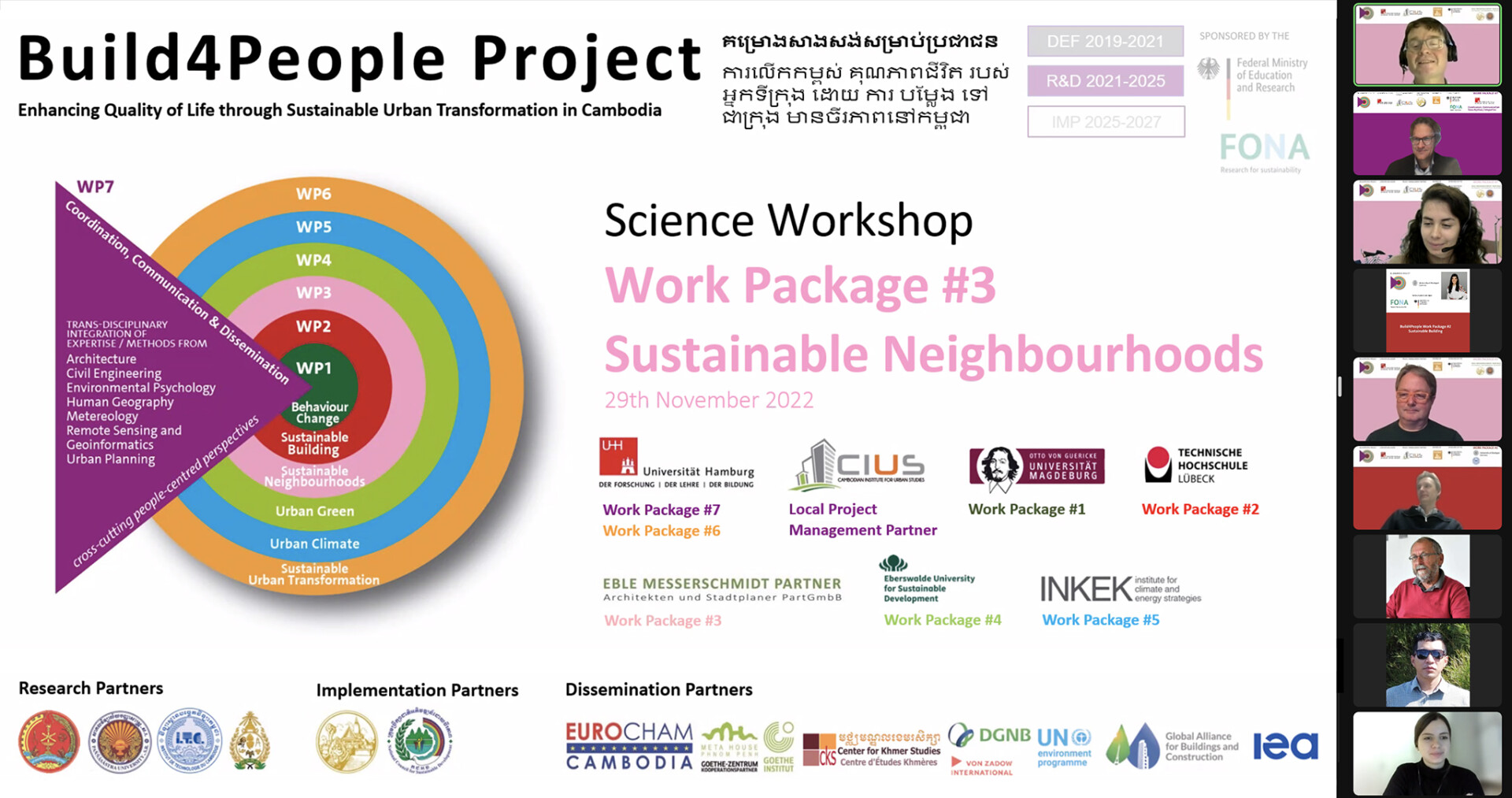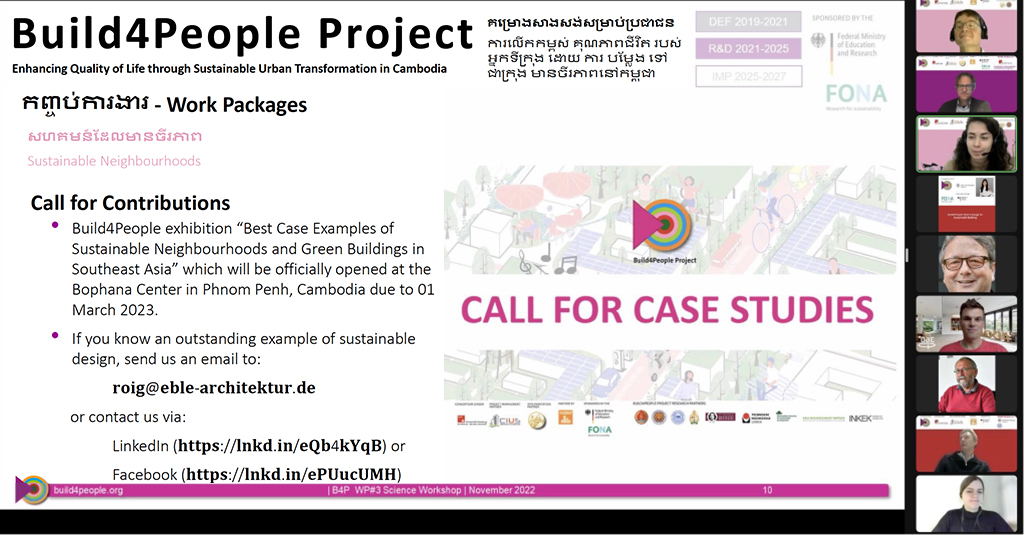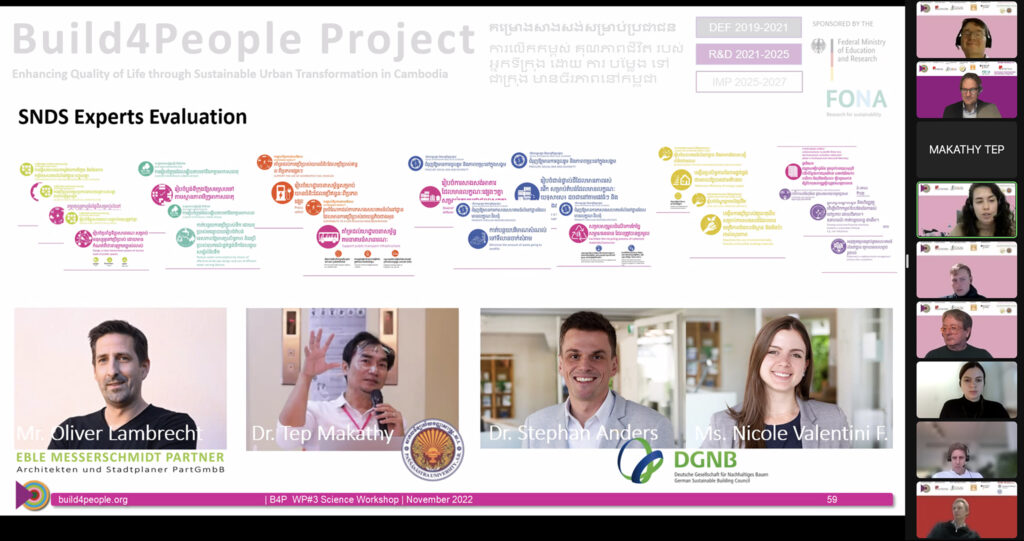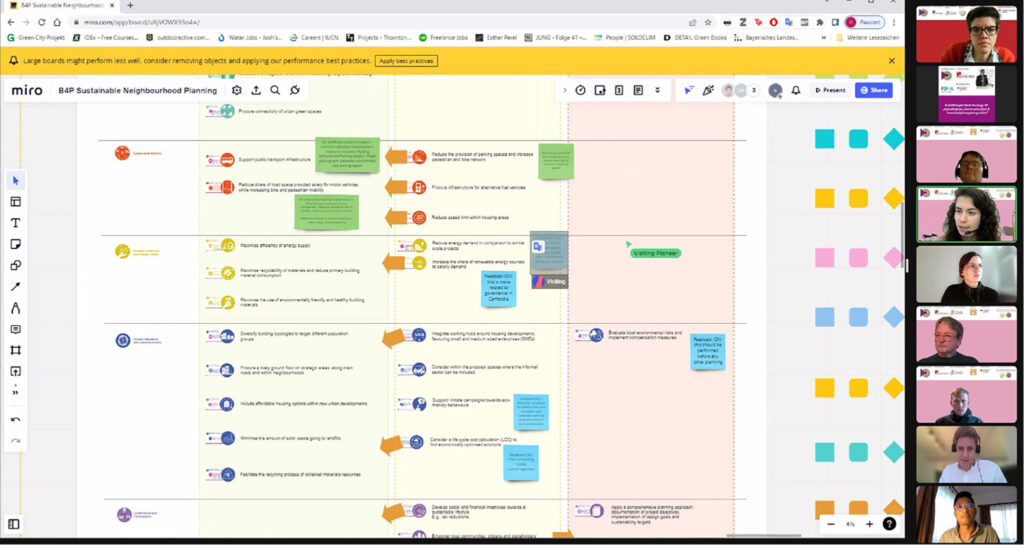
On 29 November 2022, the 2nd Science Workshop of the Build4People Work Package #3 “Sustainable Neighbourhoods” took place. It was organized and moderated by representatives from Eble Messerschmidt Partner (EMP), Rolf Messerschmidt, leader of the Build4People WP3 “Sustainable Neighbourhoods” and Nuria Mariela Roig Mejia, WP#3 Research Associate.
The event counted with the participation of renamed key speakers such as Mr. Steven Petit, creative director, landscape architect and urban designer of OMGEVING Asia, based in Ho Chi Minh City, Vietnam, Dr. Stephan Anders, Director Network and Consulting of the German Sustainable Building Council (DGNB), Mr. Sovan Sieng and Mr. Conrad Richardson, both Technical Advisors of the project “Sustainable Mobility in Metropolitan Regions” (SMMR II) with project locations in Cambodia, Vietnam and Indonesia.
Among the participants were: Mr. Phanin Cheam, Vice-Head Urban Management Division of Phnom Penh Capital Administration, and other Build4People team members such as: Dr. Michael Waibel, Build4People consortium leader, Dr. Anke Blöbaum and Ms. Ramune Pansa, respectively leader and research associate of WP#1 “Behaviour Change”, Prof. Dr. Lutz Katschner, leader of WP#5 “Urban Climate”, and Mr. Ravi Jayaweera, Research associate of WP#6 “Sustainable Urban Transformation”.
Aims
The main aim of this event was to introduce the main WP#3 research findings, to discuss the next steps in regard to the next Ecocity Transition Lab in February-March 2023. The science workshop was also an opportunity to strengthen the communication with other research projects in the Asian southeast region such as SMM.
Summary
The workshop started with a short informal exchange, welcoming and the presentation of the agenda by the WP#3 Research Associate Ms. Nuria Roig.
As introduction to the Build4People project, Michael Waibel, as consortium leader, made a concise presentation of the B4P project rationale and also took the opportunity to mention the Sustainable Building Incubator launching and the call for contribution campaign to collect information about sustainable neighbourhoods and buildings best practice examples for the 2nd Build4People exhibition in the Bophana Center due to 01 March 2023.

Following this introductory presentation, the first draft of strategies and early stages criteria for sustainable neighbourhood development was presented by Nuria Roig, WP#3 research associate. The two Ecocity transition labs were highlighted as the main source of information to identify the current situation of the city, setting the ground to develop the most adequate set of strategies. The set is divided into 6 main goals: Integrated Urban Design, Blue Green Infrastructure, Sustainable Mobility, Climate Protection & Energy Flows and Governance & Participation. Each goal subdivides into different strategies and each strategy is supported by a range of actions. Among the examples mentioned, it was the strategy related to climate responsive urban design, where the first action is related to the optimization of urban layout according to local microclimate characteristics. At this point, the role of creating wind corridors and thus, understanding first dominate wind directions as stressed, and in consequence the close synergies between the different strategies and actions.
Dr. Stephan Anders and Ms. Nicole Valentini F. then further developed the first presentation and deepened the reasoning behind the early stages criteria in the proposal. They stressed the fact that the most cost-effective mean of increasing resilience, is to plan and implement these measures at the earliest stage possible in the design process.
The presentation from the German sustainability Council Experts (DGNB) was followed by the introduction to the Impact Likelihood-Matrix by Nuria Roig, WP#3 research associate. This methodology aims to clarify the information collected during the workshops with different stake holders in Phnom Penh such as Borey Peng Huoth, Phnom Penh Capital Administration and entrepreneurs, while contrasting it with sustainability expert’s opinion. Stakeholders agave their opinion about the level of likelihood each strategy has, considering the current socio-economic and political context of the city, while the experts evaluated the level of impact each strategy has on the sustainability performance of a district. The output of this matrix’s set the ground to continue internal discussions to stablish a core set of strategies that will be brought to a design phase during the next Eco city Transition Lab in February-March 2023.
The output of the matric is divided into three areas, the green condenses the strategies that were votes as the most likely to be implemented and with the highest impact. The yellow area shows the strategies that were marked either with an intermediate likelihood and a high impact, or a high impact but an intermediate likelihood. Finally, the orange area includes the strategies that were votes with a lower likelihood and a lower impact.

After a short pause, Dr. Tep Makathy gave an overview of the urban planning system and urban development in Cambodia. He shared relevant information about the official status of districts/khan land use plans, which were reported as “drafted” and due to 2018, according to the National Policy for Spatial Planning in 2013. However, any has been finalized. A more alarming situation occurs on a Commune/Sangkat Level, where there is no record of haw many plans currently exists after they began to be developed in 2009.
Afterwards, an inspiring presentation about nature-based design solutions in the context of Vietnam was done by Mr. Steven Petit. During the presentation, he shared a master plan example that includes nature-based design solutions to reduce risk of flooding and transform green public spaces into vibrant community life centres. The mentioned that more appreciation and respect of the natural landscape is key as starting point for a congruent design, aiming to understand first the DNA of the site and thus, avoiding copy-paste Interventions.
Mr. Sovan Sien and Mr. Conrad Richardson, Technical Advisors of the project Sustainable Mobility in Metropolitan Regions (SMMR II) also shared with the Build4People team their most recent research initiative to collect data about cycling behavior in Phnom Penh. SMMII donated 50 bikes to high school students from low-income families with GPS installed to track mobility patterns. The research will focus on analysing routes, commuting times, cycling experiences while also providing cycling, maintenance and road safety trainings. The output of this initiative will be used to tailor cycling measures and policy recommendations adapted to the needs of high school students.
After this series of insightful presentations, the last part of the science workshop was an interactive session to collect feedback about the current set of strategies, according to the likelihood-impact matrix. The participants worked together on a Miro Board, where they shared their perspective about which strategies, now located with an intermediate likelihood/impact should be considered within the core set. The output of this discussion will be further processed and with the results of the Urban Quality of Life Survey conducted by our colleagues of WP#1 “Behaviour Change” in order to develop the second and final draft of the sustainable strategies for sustainable neighbourhood development.

Main inputs and conclusions
During the different discussions, many comments raised important points to be considered. Mr. Steven Petit and Ms. Nicole Valentini suggested that to further develop the strategies, it is be relevant to visualize them in terms of what it is needed first, and then making clear what can be implemented in a medium and long term.
To this, Mr. Andreas von Zadow also shared some guiding questions:
- What can be minimum measures (must do)?
- And what could be maximum measures (should do)?
- What in each strategy can be quick wins/ immediate action/low cost?
- What kind of measure are long term …?
- What in each strategy falls mainly into the field of authorities?
- What in each strategy falls mainly into the field of private developers?
- What in each strategy falls mainly into the field of NGOs/ experts?
- What in each strategy can ordinary people do right away by changing behaviour?
- Who is in charge of what?
Mr. Steven Petit also highlighted the need to consider the “money layer” to the strategies set, complementing the idea of the “time layer”, in order to define which ones could be implemented without a high initial front cost.
This valuable inputs will serve as drivers for further internal discussions within the WP#3 team and the rest of the Build4People team.